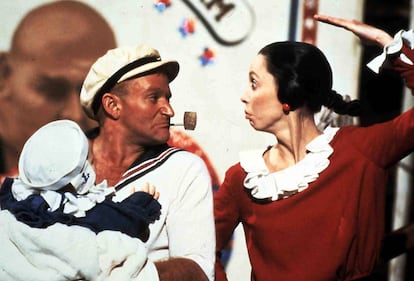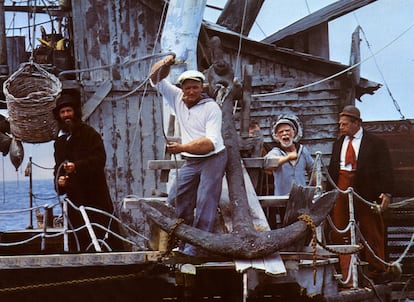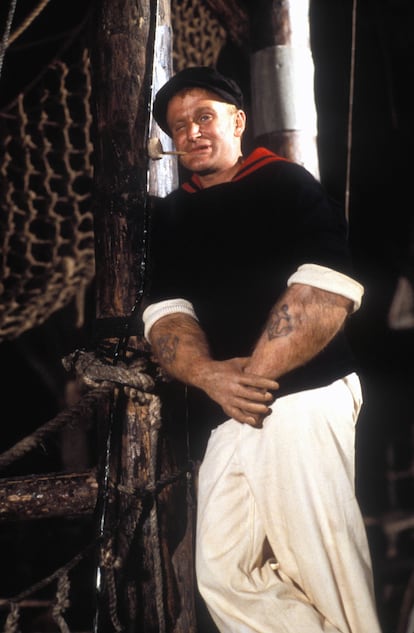The filming of Robin Williams’ ‘Popeye,’ where cocaine was hidden in walkie-talkies: ‘You couldn’t escape it’
The 1980 family comedy about the sailor’s adventures was a white powder fest off-camera, according to several witnesses who claim the merchandise was transported from Los Angeles to the Malta set in film cans


Popeye has joined the list of characters entering the public domain this year. Since January 2025, his image can be used in audiovisual material without being subject to intellectual property laws, and, as happened in previous years with the first versions of Winnie the Pooh and Mickey Mouse, this opportunity has been quickly seized upon to make not one, but two horror films based on the sailor. In Popeye the Slayer Man, a group of friends sneak into an abandoned spinach factory to investigate the legend of the Sailor Man, who is said to haunt the factory and the local docks. In Popeye’s Revenge, counselors confront an urban legend about Popeye as they prepare to open a summer camp. But try as they might, these new slashers can’t compete with the unintentionally disturbing 1980 film Popeye, starring Robin Williams and Shelley Duvall.
“The king of comics now in the flesh... and spinach,” reads the poster for the film directed by Robert Altman, conceived as a musical comedy suitable for all audiences. However, while the sailor gobbled up cans of spinach because they granted him superhuman strength and speed, what Robin Williams’ Popeye binged on was cocaine. And the result ended up being yet another example of how success in 1980s Hollywood was often marked by excess and addiction. “You couldn’t escape it [cocaine],” asserted the then-CEO of Paramount Pictures, mogul Barry Diller, in a recent talk with journalist Anderson Cooper.
The eccentric film was shot in Malta, in Anchor Bay, where the town of Sweethaven was built — a fictional location that has become a tourist attraction. Film canisters were shipped daily from there to Los Angeles, California, for development, as Diller explained: “We discovered they were actually used to ship cocaine to and from the set. Everyone was high.”

The American media mogul, current chairman of IAC/InterActiveCorp and founder of Fox Broadcasting Company, confessed during the conversation with Cooper that the effects of that white powder-fest during filming were evident in the final result that reached movie screens, where viewers were able to discern a more hectic pace than usual in the story. “Think about the speed of vinyl records,” he told the audience at the event with Cooper, held at the 92NY cultural center. “If 33 revolutions per minute is the standard speed for playing an LP on a turntable, this is a movie that plays at 78 revolutions per minute.”
Popeye was Williams’ film debut in a leading role, and he accepted the part after the first choice, Dustin Hoffman, turned it down due to disputes with the screenwriter. Williams was already a television star thanks to the sitcom Mork & Mindy, but by then he had also become heavily involved with drug and alcohol abuse, as he himself recounted on multiple occasions. “Cocaine for me was a place to hide. Most people get hyper on coke. It slowed me down,” he admitted in a 1988 interview with People.
Mork & Mindy director Howard Storm also spoke about the actor’s drug dependence during filming. “He hadn’t slept all night. He was snorting coke, and if you snort coke, in order to come down you drink booze. He was out all night and screwing everybody in town,” he recalled. In July 2014, a month before he was found dead in his home, Williams, then suffering from dementia, checked himself into a drug rehabilitation center to focus on the sobriety he’d been seeking for decades.

On the set of Popeye, however, it wasn’t Williams who drew the most attention for his drug problems. In 2020, composer Van Dyke Parks, who in addition to co-composing the score also appeared in the film as a pianist, told The Telegraph that famed producer Robert Evans — who produced classics like Chinatown and The Godfather — nearly caused a diplomatic incident when his luggage, laden with cocaine, disappeared at the airport. He was actually arrested for cocaine trafficking while the film was in post-production, but the charges were later removed from his record. “I’ll be known as Bob ‘Cocaine’ Evans until my grave,” he said in a 1994 interview.
Dyke Parks also recalled that the set was filled with hidden drugs that would appear unexpectedly at any moment, like a treasure hunt. “I was the hero of the regiment for opening a walkie-talkie to change the battery and finding a bag of cocaine. I don’t remember how much there was or who I gave it to, but I remember feeling uneasy because I knew it would influence people’s behavior and the difficulties of the production from the bottom up,” he confessed.

The film has always been considered a failure, not so much because of its box office takings — about $60 million, on a budget of $20 million — but because it was not liked by the public or the critics, nor by its stars or the executives at Paramount and Walt Disney Productions who made it possible. A day after the premiere of Popeye, on December 19, 1980, The Shining hit theaters, where Shelley Duvall played a role for which she would be infinitely more remembered than that of Olive Oyl. Williams also had plenty of subsequent work that put that Popeye behind him, such as his roles as Professor Keating in Dead Poets Society or Mrs. Doubtfire.
Shortly after the release of Popeye, the tragic loss of his friend John Belushi, who died of a cocaine and heroin overdose in 1982, was the catalyst for Williams’ decision to change his life. “His death scared a whole group of people in the entertainment world and caused a huge exodus from drugs. And then I got the baby [his firstborn, Zachary Pym, born in April 1983, from his marriage to Valerie Velardi, who also appeared in Popeye]. I knew I couldn’t be a father and live that kind of life,” he said years later. He achieved his goal for decades, but suffered several relapses, the last one shortly before his death in 2014, when he again sought professional help. No traces of drugs or alcohol were found in the autopsy.
Sign up for our weekly newsletter to get more English-language news coverage from EL PAÍS USA Edition
Tu suscripción se está usando en otro dispositivo
¿Quieres añadir otro usuario a tu suscripción?
Si continúas leyendo en este dispositivo, no se podrá leer en el otro.
FlechaTu suscripción se está usando en otro dispositivo y solo puedes acceder a EL PAÍS desde un dispositivo a la vez.
Si quieres compartir tu cuenta, cambia tu suscripción a la modalidad Premium, así podrás añadir otro usuario. Cada uno accederá con su propia cuenta de email, lo que os permitirá personalizar vuestra experiencia en EL PAÍS.
¿Tienes una suscripción de empresa? Accede aquí para contratar más cuentas.
En el caso de no saber quién está usando tu cuenta, te recomendamos cambiar tu contraseña aquí.
Si decides continuar compartiendo tu cuenta, este mensaje se mostrará en tu dispositivo y en el de la otra persona que está usando tu cuenta de forma indefinida, afectando a tu experiencia de lectura. Puedes consultar aquí los términos y condiciones de la suscripción digital.

